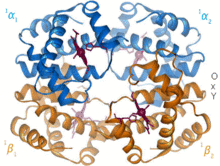Structural biology
| Part of a series on |
| Biochemistry |
|---|
 |
|
Structural biology is a branch of molecular biology, biochemistry, and biophysics concerned with the molecular structure of biological macromolecules (especially proteins, made up of amino acids, RNA or DNA, made up of nucleotides, and membranes, made up of lipids), how they acquire the structures they have, and how alterations in their structures affect their function.[1] This subject is of great interest to biologists because macromolecules carry out most of the functions of cells, and it is only by coiling into specific three-dimensional shapes that they are able to perform these functions. This architecture, the "tertiary structure" of molecules, depends in a complicated way on each molecule's basic composition, or "primary structure."
In the past few years it has become possible for highly accurate physical molecular models to complement the in silico study of biological structures. Examples of these models can be found in the Protein Data Bank.
Computational techniques like Molecular Dynamics simulations can be used in conjunction with empirical structure determination strategies to extend and study protein structure, conformation and function.[2]


History[]
In 1912 Max Von Laue directed X-Ray's at crystallized copper sulfate generating a diffraction pattern.[3] These experiments led to the development of X-Ray Crystallography, and its usage in exploring biological structures. Pepsin crystals were the first proteins to be crystallized for use in X-Ray diffraction, by Theodore Svedberg.[4] The first tertiary protein structure, that of Myoglobin, was published in 1958 by John Kendrew.[5] During this time, modeling of protein structures was done using balsa wood or wire models.[6] With the invention of modeling software such as CCP4 in the late 1970's,[7] modeling is now done with computer assistance. Recent developments in the field have included the generation of X-Ray free electron lasers, allowing analysis of previously hidden structures[8] and the use of structural biology in assisting synthetic biology[9]
Techniques[]
Biomolecules are too small to see in detail even with the most advanced light microscopes. The methods that structural biologists use to determine their structures generally involve measurements on vast numbers of identical molecules at the same time. These methods include:
- Mass spectrometry
- Macromolecular crystallography
- Neutron diffraction
- Proteolysis
- Nuclear magnetic resonance spectroscopy of proteins (NMR)
- Electron paramagnetic resonance (EPR)
- Cryogenic Electron Microscopy (cryoEM)
- Electron crystallography and Microcrystal electron diffraction
- Multiangle light scattering
- Small angle scattering
- Ultrafast laser spectroscopy
- Dual-polarization interferometry and circular dichroism
Most often researchers use them to study the "native states" of macromolecules. But variations on these methods are also used to watch nascent or denatured molecules assume or reassume their native states. See protein folding.
A third approach that structural biologists take to understanding structure is bioinformatics to look for patterns among the diverse sequences that give rise to particular shapes. Researchers often can deduce aspects of the structure of integral membrane proteins based on the membrane topology predicted by hydrophobicity analysis. See protein structure prediction.
See also[]
- Primary structure
- Secondary structure
- Tertiary structure
- Quaternary structure
- Structural domain
- Structural motif
- Protein subunit
- Molecular model
- Cooperativity
- Chaperonin
- Structural genomics
- Stereochemistry
- Resolution (electron density)
- Proteopedia The collaborative, 3D encyclopedia of proteins and other molecules.
- Protein structure prediction
References[]
- ^ Banaszak LJ (2000). Foundations of Structural Biology. Burlington: Elsevier. ISBN 9780080521848.
- ^ Karplus M, McCammon JA (September 2002). "Molecular dynamics simulations of biomolecules". Nature Structural Biology. 9 (9): 646–52. doi:10.1038/nsb0902-646. PMID 12198485. S2CID 590640.
- ^ Curry S (July 2015). "Structural Biology: A Century-long Journey into an Unseen World". Interdisciplinary Science Reviews. 40 (3): 308–328. doi:10.1179/0308018815z.000000000120. PMC 4697198. PMID 26740732.
- ^ Jaskolski M, Dauter Z, Wlodawer A (September 2014). "A brief history of macromolecular crystallography, illustrated by a family tree and its Nobel fruits". The FEBS Journal. 281 (18): 3985–4009. doi:10.1111/febs.12796. PMC 6309182. PMID 24698025.
- ^ Kendrew JC, Bodo G, Dintzis HM, Parrish RG, Wyckoff H, Phillips DC (March 1958). "A three-dimensional model of the myoglobin molecule obtained by x-ray analysis". Nature. 181 (4610): 662–6. doi:10.1038/181662a0. PMID 13517261. S2CID 4162786.
- ^ Garman EF (March 2014). "Developments in x-ray crystallographic structure determination of biological macromolecules". Science. 343 (6175): 1102–8. doi:10.1126/science.1247829. PMID 24604194. S2CID 21067016.
- ^ "About CCP4". legacy.ccp4.ac.uk. Retrieved 2021-04-02.
- ^ Waldrop MM (January 2014). "X-ray science: The big guns". Nature. 505 (7485): 604–6. doi:10.1038/505604a. PMID 24476872.
- ^ Kiel C, Serrano L (November 2012). "Structural data in synthetic biology approaches for studying general design principles of cellular signaling networks". Structure. 20 (11): 1806–13. doi:10.1016/j.str.2012.10.002. PMID 23141693.
External links[]
| At Wikiversity, you can learn more and teach others about Structural biology at the Department of Structural biology |
- Structural biology
- Molecular biology
- Protein structure
- Biophysics
